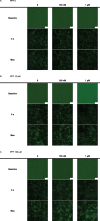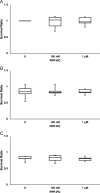Effect of preconditioning on propofol-induced neurotoxicity during the developmental period
- PMID: 35984772
- PMCID: PMC9390907
- DOI: 10.1371/journal.pone.0273219
Effect of preconditioning on propofol-induced neurotoxicity during the developmental period
Abstract
At therapeutic concentrations, propofol (PPF), an anesthetic agent, significantly elevates intracellular calcium concentration ([Ca2 +]i) and induces neural death during the developmental period. Preconditioning enables specialized tissues to tolerate major insults better compared with tissues that have already been exposed to sublethal insults. Here, we investigated whether the neurotoxicity induced by clinical concentrations of PPF could be alleviated by prior exposure to sublethal amounts of PPF. Cortical neurons from embryonic day (E) 17 Wistar rat fetuses were cultured in vitro, and on day in vitro (DIV) 2, the cells were preconditioned by exposure to PPF (PPF-PC) at either 100 nM or 1 μM for 24 h. For morphological observations, cells were exposed to clinical concentrations of PPF (10 μM or 100 μM) for 24 h and the survival ratio (SR) was calculated. Calcium imaging revealed significant PPF-induced [Ca2+]i elevation in cells on DIV 4 regardless of PPF-PC. Additionally, PPF-PC did not alleviate neural cell death induced by PPF under any condition. Our findings indicate that PPF-PC does not alleviate PPF-induced neurotoxicity during the developmental period.
Conflict of interest statement
The authors have declared that no competing interests exist.
Figures







Similar articles
-
Intravenous anesthetic-induced calcium dysregulation and neurotoxic shift with age during development in primary cultured neurons.Neurotoxicology. 2018 Dec;69:320-329. doi: 10.1016/j.neuro.2018.08.002. Epub 2018 Aug 11. Neurotoxicology. 2018. PMID: 30107222
-
Propofol inhibited autophagy through Ca2+/CaMKKβ/AMPK/mTOR pathway in OGD/R-induced neuron injury.Mol Med. 2018 Nov 23;24(1):58. doi: 10.1186/s10020-018-0054-1. Mol Med. 2018. PMID: 30470173 Free PMC article.
-
Propofol protects cultured brain cells from iron ion-induced death: comparison with trolox.Eur J Pharmacol. 2000 Sep 15;404(1-2):21-7. doi: 10.1016/s0014-2999(00)00496-9. Eur J Pharmacol. 2000. PMID: 10980259
-
Recent Insights Into Molecular Mechanisms of Propofol-Induced Developmental Neurotoxicity: Implications for the Protective Strategies.Anesth Analg. 2016 Nov;123(5):1286-1296. doi: 10.1213/ANE.0000000000001544. Anesth Analg. 2016. PMID: 27551735 Free PMC article. Review.
-
Relationship between ketamine-induced developmental neurotoxicity and NMDA receptor-mediated calcium influx in neural stem cell-derived neurons.Neurotoxicology. 2017 May;60:254-259. doi: 10.1016/j.neuro.2016.04.015. Epub 2016 Apr 27. Neurotoxicology. 2017. PMID: 27132109 Review.
Cited by
-
Propofol is involved in neurotoxicity by mediating the occurrence of ferroptosis.Medicine (Baltimore). 2025 Jul 25;104(30):e43390. doi: 10.1097/MD.0000000000043390. Medicine (Baltimore). 2025. PMID: 40725868 Free PMC article.
-
Research progress on molecular mechanisms of general anesthetic-induced neurotoxicity and cognitive impairment in the developing brain.Front Neurol. 2022 Nov 24;13:1065976. doi: 10.3389/fneur.2022.1065976. eCollection 2022. Front Neurol. 2022. PMID: 36504660 Free PMC article. Review.
-
From neurotoxicity to neuroprotection: Rethinking GABAAR-targeting anesthetics.Cell Biol Toxicol. 2025 Jun 14;41(1):104. doi: 10.1007/s10565-025-10057-z. Cell Biol Toxicol. 2025. PMID: 40516005 Free PMC article. Review.
-
Role of ferroptosis in hypoxic preconditioning to reduce propofol neurotoxicity.Front Pharmacol. 2023 Feb 2;14:1121280. doi: 10.3389/fphar.2023.1121280. eCollection 2023. Front Pharmacol. 2023. PMID: 36817119 Free PMC article.
References
-
- Shibuta S, Kanemura S, Uchida O, Mashimo T. The influence of initial target effect-site concentrations of propofol on the similarity of effect-sites concentrations at loss and return of consciousness in elderly female patients with the Diprifusor system. J Anaesthesiol Clin Pharmacol. 2012;28: 194–199. doi: 10.4103/0970-9185.94851 - DOI - PMC - PubMed
Publication types
MeSH terms
Substances
LinkOut - more resources
Full Text Sources
Research Materials
Miscellaneous

